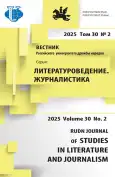‘Third Meanings’: On the Semantics of the Sign Elements Position in Polycode Texts
- Authors: Kemarskaya I.N.1
-
Affiliations:
- Academy of Media Industry
- Issue: Vol 30, No 2 (2025)
- Pages: 346-360
- Section: JOURNALISM
- URL: https://journal-vniispk.ru/2312-9220/article/view/319133
- DOI: https://doi.org/10.22363/2312-9220-2025-30-2-346-360
- EDN: https://elibrary.ru/JVPZTQ
- ID: 319133
Cite item
Full Text
Abstract
The relevance of the topic is determined by the scientific community growing interest in the problems of the media texts polysemiotic impact. The aim of the article is to rethink in relation to modern, radically changed technologies the Umberto Eco’s concept of structuring audiovisual text (1970s). The author focuses on the semiotic-rhetorical interpretation of the tools used by Eco, as well as on his vocabulary, with the specification of parameters related to the potential distribution of meanings across the registers of the polycode text. The study is based on the methodology of applied semiotics, which allows the analysis of television programs as individual cultural phenomena, by eliminating the direct content of the episodes, while maintaining the general principles of systematicity, integrity and complexity. Given article focuses on the problematic areas of media communication and on the mechanisms of viewer correlation of words and images that reveal additional meanings to the screen-text. The author examines the symbolic elements of coded and non-coded nature, and the mechanisms of their perception by the media recipients. The ligaments between the visual and verbal fragments are consistently laid down at the stage of the author’s media message creation, based on the principles of illustrativeness and (or) paradoxality. Their potential integral impact on the viewer leads to the conclusion about the holistic nature of the media message perception by the audience, which doesn’t divide the polycode text into autonomous components. The transforming of the word’ position towards the image can be the source either of the obvious (clarified) or unexpected (unspoken) perceived meanings.
Keywords
About the authors
Irina N. Kemarskaya
Academy of Media Industry
Author for correspondence.
Email: kemarskaya2011@yandex.ru
ORCID iD: 0000-0001-7593-8042
SPIN-code: 7827-5046
Grand PhD in Philology, Leading Researcher, Research Sector
105 Oktyabrskaya St, bldg 2, Moscow, 127521, Russian FederationReferences
- Bahtin, M.M. (1979). Aesthetics of Verbal Creativity. Мoscow: Iskusstvo Publ. (In Russ.)
- Barthes, R. (2015). The Third Sense. Мoscow: Ad Marginem Press. (In Russ.)
- Berezhnaia, M.A. (2016). Dominants of Audiovisual Text in the Aspect of TV Discourses Research. Vestnik SPbSU. Series 9. Philology. Asian Studies. Journalism, 3, 147–156. (In Russ.) https://doi.org/10.21638/11701/spbu09.2016.317
- Eco, U. (2023). About Television: Articles and Essays 1956–2015. Мoscow: AST; Corpus Publ. (In Russ.)
- Eco, U. (1972). Towards a Semiotic Inquiry into the Television Message. Working Papers in Cultural Studies, (2), 103–121.
- Eisenstein, S.M. (2016). Behind the Scenes. Key Works on Cinema Theory. Moscow: Academic Project; Gaudeamus Publ. (In Russ.)
- Ekman, P. (2013). Emotions Revealed. Psychology of Emotions. I know What You Feel. Moscow: Piter Publ. (In Russ.)
- Gajmakova, B.D., Makarova, S.K., Novikova, V.I., & Ossovskaya, M.P. (2004). Mastery of On-air Performance. Study Guide. Мoscow: Aspect Press. (In Russ.)
- Gambier, Y. (2020). Change and Continuity in Translation. Renewing Communication in a Globalised World. Studies about Languages, 37, 5–19. http://dx.doi.org/10.5755/j01.sal.1.37.27760
- Gunning, T. (2006). Attractions: How They Came into the World. In W. Strauven (Ed.), The Cinema of Attractions Reloaded (pp. 31–41). Amsterdam University Press.
- Kaneman, D. (2014). Thinking, Fast and Slow. Мoscow: AST Publ. (In Russ.)
- Kozulyaev, A.V. (2017). Fundamentals of Innovative Methodology of Formation of Professional Competences of Audiovisual Interpreter. Innovative Projects and Programmes in Education, (6), 55–62. (In Russ.)
- Lotman, Yu., & Tsivyan, Yu. (1994). Dialogue with the Screen. Tallin: Alexandra Publ. (In Russ.)
- Maksimov, V.I. (2021). The Theoretical Basis of the Modern Dance. Bulletin of the Vaganova Ballet Academy, (6), 45–55. (In Russ.)
- Manovich, L. (2007). Understanding Hybrid Media. In Betti-Sue Hertz (Ed.), Animated Paintings (pp. 1–18). San Diego Museum of Art Publ.
- Mansfield, J. (1992). Narration and Editing: Sound for Television. BBC Television Training Publ.
- Mikhalkovich, V.I. (1996). Essay on the Theory of Television. Мoscow: State Institute for Art Studies Publ. (In Russ.)
- Mikhalkovich, V.I. (1998). On the Essence of Television. Мoscow: IPK Publ. (In Russ.)
- Muratov, S.A. (2009). Television in Search of Television. Chronicle of Author’s Observations. Мoscow State University Publ. (In Russ.)
- Ousmanova, A. (2019). The Poetics of the Unspeakable and ‘Le Filmique’ in the Works of Roland Barthes. Topos. Journal for Philosophy and Cultural Studies, (1–2), 150–176. (In Russ.) https://doi.org/10.24412/1815-0047-2019-1-2-150-176
- Pronin, A.A. (2017). Mass-doc: Presumption of Narrativity. Saint Petersburg: Petropolis Publ. (In Russ.)
- Sergeeva, Yu.M., & Uvarova, E.A. (2014). Polycode Text: Peculiarities of Structure and Perception. Science and School, (4), 128–134. (In Russ.)
- Smith, A.N. (2018). Storytelling Industries. Narrative Production in the 21st Century. Palgrave Macmillan Cham.
- Urtmintseva, M.G., & Skachkova, V.N. (2022). Voice-Over Text in Documentary Film Discourse. Nauchnyi dialog, 11(6), 334–349. (In Russ.) https://doi.org/10.24224/2227-1295-2022-11-6-334-349
- Volkova, I.I. (2018). The Streaming Phenomenon: Journalism of the Future? In V.P. Vorobyov (Ed.), Multimedia journalism: collection of scientific papers of the International Scientific and Practical Conference (pp. 213–218). Minsk: BSU Publ. (In Russ.)
- Weissmann, E. (2019). Book Review: Storytelling Industries. Narrative Production in the 21st Century. Critical Studies in Television, Manchester University Press, 14(1), 146–149. https://doi.org/10.1177/1749602018818288c
Supplementary files









